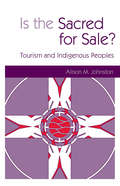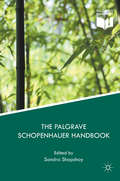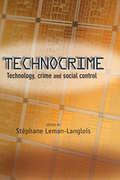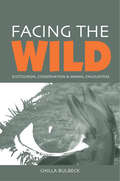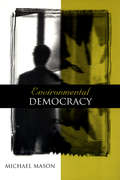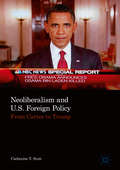- Table View
- List View
Is the Sacred for Sale: Tourism and Indigenous Peoples
by Alison M Johnston'Definitely a book that sheds light on perspectives and perceptions about today's global economy. A must read for tourists and corporations alike - also heads of state, the media and environment groups - all of whom need to be informed on this key subject.' Chief Garry John, Chair and Spokesperson, St'at'imc Chiefs' Council 'an activist's call to action on behalf of people who have been made invisible in the merciless spread of globalization under corporate control.' Nina Rao, Southern Co Chair of the Tourism Caucus at the UN Commission on Sustainable Development, and Professor of Tourism 'A powerful and much-needed tool to fight the seemingly all-pervasive ignorance in the corporate and consumer-driven world that continues to hail ecotourism and other tourism 'alternatives' as beneficial to local people without looking at the root causes of problems.' Anita Pleumarom, Tourism Investigation and Monitoring Team, Bangkok Tourism is the fastest growing industry in the world. Ecotourism, often considered a more benign form of tourism, can in fact cause the most damage, as it targets more vulnerable environments and cultures. Is the Sacred for Sale? looks at our present crossroads in consumer society. It analyses the big questions of tourism, clarifying how tourism can support biodiversity conservation. It also offers a cross-cultural window to the divide between corporate thinking and sacred knowledge, to help us understand why collisions over resources and land use are escalating. Finally, we have a full spectrum of information for healthy dialogue and new relationships. This book is a profound wake up call to the business world and to decision-makers who shape current policy. It poses important questions to us all and is a must read for every tourist and traveller.
Intelligent Instruction Computer: Theory And Practice
by Marshall J. Farr Joseph PsotkaThis text records the dramatic new prospects for computers in instruction in school, the workplace and high technology research facilities. If offers teachers and trainers a vision of how their professions will be fundamentally altered by these new systems and how their roles will be changed. The challenges and opportunities exposed by these developments in intelligent instruction by computer are many. Topics discussed include: apprenticeship and training in the workplace; automated tutoring in interactive environment; two approaches to simulation composition for training; and transfer, adaption, and use of intelligent tutoring technology.
Genomics and Society: "Legal, Ethical and Social Dimensions"
by George Gaskell Martin W BauerThe impact of genomics on society has been the focus of debate and conflict across the world. Contrasting views of risks and benefits, trust in science and regulation, the understanding of science, media coverage and mobilization of the public by civil society groups all have been cited as drivers of public opinion. The long running controversy is a signal that the public's view cannot be ignored in the development and implementation of new technologies arising out of genomics such as agricultural biotechnologies, genetic testing and the uses of genetic information, the cloning of human cells and tissues and transgenic animals. Written by a progressive international group of social scientists from Europe, North America and Japan, this volume presents a series of comparative perspectives on the social, ethical and legal implications of genomics. The result is a book which encapsulates the lessons to be learned from the controversies of the 1990s and raises the level of debate on the societal implications of new developments in genomics.
Intelligent Instruction Computer: Theory And Practice
by Marshall J. Farr Joseph PsotkaThis text records the dramatic new prospects for computers in instruction in school, the workplace and high technology research facilities. If offers teachers and trainers a vision of how their professions will be fundamentally altered by these new systems and how their roles will be changed. The challenges and opportunities exposed by these developments in intelligent instruction by computer are many. Topics discussed include: apprenticeship and training in the workplace; automated tutoring in interactive environment; two approaches to simulation composition for training; and transfer, adaption, and use of intelligent tutoring technology.
Working for Oil: Comparative Social Histories of Labor in the Global Oil Industry
by Touraj Atabaki Elisabetta Bini Kaveh EhsaniThis volume examines the social history of oil workers and investigates how labor relations have shaped the global oil industry during the twentieth century and today. It brings together the work of scholars from a range of disciplines, approaching the social, political, economic and cultural dimensions of oil. The contributors analyze a number of key oil producing regions, including the Americas, the Middle East, Central Asia, the Caucasus, Europe and Africa.
Working for Oil: Comparative Social Histories of Labor in the Global Oil Industry
by Touraj Atabaki Elisabetta Bini Kaveh EhsaniThis volume examines the social history of oil workers and investigates how labor relations have shaped the global oil industry during the twentieth century and today. It brings together the work of scholars from a range of disciplines, approaching the social, political, economic and cultural dimensions of oil. The contributors analyze a number of key oil producing regions, including the Americas, the Middle East, Central Asia, the Caucasus, Europe and Africa.
The Palgrave Schopenhauer Handbook
by Sandra ShapshayThis comprehensive Handbook offers a leading-edge yet accessible guide to the most important facets of Arthur Schopenhauer’s philosophical system, the last true system of German philosophy. Written by a diverse, international and interdisciplinary group of eminent and up-and-coming scholars, each of the 28 chapters in this Handbook includes an authoritative exposition of different viewpoints as well as arguing for a particular thesis. Authors also put Schopenhauer’s ideas into historical context and connect them when possible to contemporary philosophy.Key features: Structured in six parts, addressing the development of Schopenhauer’s system, his epistemology and metaphysics, aesthetics and philosophy of art, ethical and political thought, philosophy of religion and legacy in Britain, France, and the US.Special coverage of Schopenhauer’s treatment of Judaism, Christianity, Vedic thought and BuddhismAttention to the relevance of Schopenhauer for contemporary metaphysics, metaethics and ethics in particular. The Palgrave Schopenhauer Handbook is an essential resource for scholars as well as advanced students of nineteenth-century philosophy. Researchers and graduate students in musicology, comparative literature, religious studies, English, French, history, and political science will find this guide to be a rigorous and refreshing Handbook to support their own explorations of Schopenhauer’s thought.
The Palgrave Schopenhauer Handbook
by Sandra ShapshayThis comprehensive Handbook offers a leading-edge yet accessible guide to the most important facets of Arthur Schopenhauer’s philosophical system, the last true system of German philosophy. Written by a diverse, international and interdisciplinary group of eminent and up-and-coming scholars, each of the 28 chapters in this Handbook includes an authoritative exposition of different viewpoints as well as arguing for a particular thesis. Authors also put Schopenhauer’s ideas into historical context and connect them when possible to contemporary philosophy.Key features: Structured in six parts, addressing the development of Schopenhauer’s system, his epistemology and metaphysics, aesthetics and philosophy of art, ethical and political thought, philosophy of religion and legacy in Britain, France, and the US.Special coverage of Schopenhauer’s treatment of Judaism, Christianity, Vedic thought and BuddhismAttention to the relevance of Schopenhauer for contemporary metaphysics, metaethics and ethics in particular. The Palgrave Schopenhauer Handbook is an essential resource for scholars as well as advanced students of nineteenth-century philosophy. Researchers and graduate students in musicology, comparative literature, religious studies, English, French, history, and political science will find this guide to be a rigorous and refreshing Handbook to support their own explorations of Schopenhauer’s thought.
Technocrime: Technology, Crime and Social Control
by Stéphane Leman-LangloisThis book is concerned with the concept of 'technocrime'. The term encompasses crimes committed on or with computers - the standard definition of cybercrime - but it goes well beyond this to convey the idea that technology enables an entirely new way of committing, combating and thinking about criminality, criminals, police, courts, victims and citizens. Technology offers, for example, not only new ways of combating crime, but also new ways to look for, unveil, and label crimes, and new ways to know, watch, prosecute and punish criminals. Technocrime differs from books concerned more narrowly with cybercrime in taking an approach and understanding of the scope of technology's impact on crime and crime control. It uncovers mechanisms by which behaviours become crimes or cease to be called crimes. It identifies a number of corporate, government and individual actors who are instrumental in this construction. And it looks at the beneficiaries of increased surveillance, control and protection as well as the targets of it. Chapters in the book cover specific technologies (e.g. the use of CCTV in various settings; computers, hackers and security experts; photo radar) but have a wider objective to provide a comparative perspective and some broader theoretical foundations for thinking about crime and technology than have existed hitherto. This is a pioneering book which advances our understanding of the relationship between crime and technology, drawing upon the disciplines of criminology, political science, sociology, psychology, anthropology, surveillance studies and cultural studies.
The Use of Punishment
by Sean McConvilleIn recent decades there has been a vast increase in the use of imprisonment and penal supervision, and to many this development appears to be qualitatively as well as quantitatively different. The causes of this development, its consequences and future course form the main point of departure for the contributors to this volume, who consider the changes that have contributed to these apparently fundamental shifts in the use of punishment. In this major new book contributors from a range of disciplines provide an integrated approach to a range of questions surrounding the use of punishment: In what ways have broader social institutions and processes contributed to penal expansion? This book is the principal outcome of the Guggenheim Punishment Project which aimed for a truly interdisciplinary account of thinking about punishment, and an outcome which was general and reflective rather than specific and policy oriented, and accessible to the generalist as well as those with a specialist interest in the field.
Facing the Wild: "Ecotourism, Conservation and Animal Encounters"
by Chilla BulbeckWhat do wild animals mean to humans? Will they survive both rampant habitat loss and extinction caused by human encroachment and, as ecotourists, our enthusiasm for them? With ecotourism now the fastest growing segment of tourism, and encounters with wild animals - be it swimming with dolphins, going on safari or bird watching - ever more popular, these are critical questions. Yet until now little has been known about why people crave encounters with wild animals and the meaning for the ecotourism industry, conservation efforts and society at large. Facing the Wild is the first serious empirical examination of why people seek out animals in their natural environment, what the desire for this experience tells us about the meanings of animals, nature, authenticity and wilderness in contemporary industrialized societies, and whether visitors change their environmental perspectives and behaviour, as the custodians of wildlife parks would like them to. The book explores the contradictions and ambivalence that so many people experience in the presence of 'wild nature' - in loving it we may diminish it and in the act of wanting to see it we may destroy it. Ultimately the book makes a case for 'respectful stewardship' of a 'hybrid nature' and provides insight for both practitioners and ecotourists alike.
Environmental Democracy: A Contextual Approach
by Michael MasonThrough a wide range of case studies, Mason reveals just how sensitive we all must be to styles of power, vulnerability and resilience in any democratic transition to sustainability. This is a fine book.' Timothy O'Riordan, Professor of Environmental Science, University of East Anglia, and Associate Director, Centre for Social and Economic Research on the Global Environment. Civic self-determination and ecological sustainability are widely accepted as two of the most important public goals. This book explains how they can be combined. Using vivid and telling case studies from around the world, it shows how liberal rights can include both ecological and social conditions for collective decision-making - environmentalist goals and social justice can be achieved together. Integrating theory and original case studies, the book makes a very significant contribution to the fundamentals of how environmental democracy can be advanced at all levels. Cogently argued and engaged, Environmental Democracy provides a superb teaching text and a source of ideas and persuasive arguments for the politically and environmentally engaged. It will be essential reading for students, teachers and researchers in politics, policy studies, environmental studies, geography and social science.
Killing Orders: Talat Pasha’s Telegrams and the Armenian Genocide
by Taner AkçamThe book represents an earthquake in genocide studies, particularly in the field of Armenian Genocide research. A unique feature of the Armenian Genocide has been the long-standing efforts of successive Turkish governments to deny its historicity and to hide the documentary evidencesurrounding it. This book provides a major clarification of the often blurred lines between facts and truth in regard to these events. The authenticity of the killing orders signed by Ottoman Interior Minister Talat Pasha and the memoirs of the Ottoman bureaucrat Naim Efendi have been two of the most contested topics in this regard. The denialist school has long argued that these documents and memoirs were all forgeries, produced by Armenians to further their claims. Taner Akçam provides the evidence to refute the basis of these claims and demonstrates clearly why the documents can be trusted as authentic, revealing the genocidal intent of the Ottoman-Turkish government towards its Armenian population. As such, this work removes a cornerstone from the denialist edifice, and further establishes the historicity of the Armenian Genocide.
Killing Orders: Talat Pasha’s Telegrams and the Armenian Genocide
by Taner AkçamThe book represents an earthquake in genocide studies, particularly in the field of Armenian Genocide research. A unique feature of the Armenian Genocide has been the long-standing efforts of successive Turkish governments to deny its historicity and to hide the documentary evidencesurrounding it. This book provides a major clarification of the often blurred lines between facts and truth in regard to these events. The authenticity of the killing orders signed by Ottoman Interior Minister Talat Pasha and the memoirs of the Ottoman bureaucrat Naim Efendi have been two of the most contested topics in this regard. The denialist school has long argued that these documents and memoirs were all forgeries, produced by Armenians to further their claims. Taner Akçam provides the evidence to refute the basis of these claims and demonstrates clearly why the documents can be trusted as authentic, revealing the genocidal intent of the Ottoman-Turkish government towards its Armenian population. As such, this work removes a cornerstone from the denialist edifice, and further establishes the historicity of the Armenian Genocide.
Neoliberalism and U.S. Foreign Policy: From Carter to Trump
by Catherine V. ScottWhile there has been a flood of scholarly efforts to extend, adapt, and revise Foucault’s exploration of the emergence and operations of neoliberalism, the study of foreign policy has remained steeped in the analysis of partisanship, institutions, policies, and personality and their influence on various issue areas, toward particular countries, or specific presidential doctrines. This book brings the political rationality of neoliberalism to bear on U.S. foreign policy in two distinct ways. First, it challenges, complicates, and revises the numerous interpretations of U.S. nationalism that posit a homologous relationship between “1898” and contemporary nationalism, instead arguing that alterations in the operations of capitalism and its correlative forms of governance have produced a differently formatted nationalism, which in turn has produced different operations of U.S. hegemony in the twenty-first century that markedly depart from earlier eras. Second, this book argues for a new timeline—one that starts with the Carter-Reagan era and the crisis of capitalism—ultimately encouraging us to think beyond particular presidencies, wars, bureaucratic politics, and policies in order to train our sights on how long-term and sustained shifts in the economy and attendant government practices have emerged to produce new myths of exceptionalism that more fully cohere with the neoliberal foundations of the U.S. nation-state.
Neoliberalism and U.S. Foreign Policy: From Carter to Trump
by Catherine V. ScottWhile there has been a flood of scholarly efforts to extend, adapt, and revise Foucault’s exploration of the emergence and operations of neoliberalism, the study of foreign policy has remained steeped in the analysis of partisanship, institutions, policies, and personality and their influence on various issue areas, toward particular countries, or specific presidential doctrines. This book brings the political rationality of neoliberalism to bear on U.S. foreign policy in two distinct ways. First, it challenges, complicates, and revises the numerous interpretations of U.S. nationalism that posit a homologous relationship between “1898” and contemporary nationalism, instead arguing that alterations in the operations of capitalism and its correlative forms of governance have produced a differently formatted nationalism, which in turn has produced different operations of U.S. hegemony in the twenty-first century that markedly depart from earlier eras. Second, this book argues for a new timeline—one that starts with the Carter-Reagan era and the crisis of capitalism—ultimately encouraging us to think beyond particular presidencies, wars, bureaucratic politics, and policies in order to train our sights on how long-term and sustained shifts in the economy and attendant government practices have emerged to produce new myths of exceptionalism that more fully cohere with the neoliberal foundations of the U.S. nation-state.
Wind Energy - The Facts: A Guide to the Technology, Economics and Future of Wind Power
by European Wind Energy AssociationWind power is often held up as the most accessible and cost-effective route to reducing our reliance on fossil fuels and improving our energy independence, yet knowledge of what it offers is often clouded by myths and misunderstandings, which can hamper its adoption. This new book, the result of an ambitious project coordinated by the European Wind Energy Association, aims to present the facts about wind energy. It includes six sections discussing: - Technology - Grid integration - Economics of wind - Its industry and markets - Its environmental impacts - The scenarios and targets for wind energy Contributions are drawn from nine leading research bodies across Europe, and the material is global in its scope. It is therefore an essential resource and reference for those whose work or study demands an in-depth examination of the subject, and for anyone who wants detailed, accurate and up-to-date information on this key energy source.
Wind Energy - The Facts: A Guide to the Technology, Economics and Future of Wind Power
by European Wind Energy AssociationWind power is often held up as the most accessible and cost-effective route to reducing our reliance on fossil fuels and improving our energy independence, yet knowledge of what it offers is often clouded by myths and misunderstandings, which can hamper its adoption. This new book, the result of an ambitious project coordinated by the European Wind Energy Association, aims to present the facts about wind energy. It includes six sections discussing: - Technology - Grid integration - Economics of wind - Its industry and markets - Its environmental impacts - The scenarios and targets for wind energy Contributions are drawn from nine leading research bodies across Europe, and the material is global in its scope. It is therefore an essential resource and reference for those whose work or study demands an in-depth examination of the subject, and for anyone who wants detailed, accurate and up-to-date information on this key energy source.
Whole System Design: An Integrated Approach to Sustainable Engineering
by Peter Stansinoupolos Michael H Smith Karlson Hargroves Cheryl DeshaWhole System Design is increasingly being seen as one of the most cost-effective ways to both increase the productivity and reduce the negative environmental impacts of an engineered system. A focus on design is critical, as the output from this stage of the project locks in most of the economic and environmental performance of the designed system throughout its life, which can span from a few years to many decades. Indeed, it is now widely acknowledged that all designers - particularly engineers, architects and industrial designers - need to be able to understand and implement a whole system design approach. This book provides a clear design methodology, based on leading efforts in the field, and is supported by worked examples that demonstrate how advances in energy, materials and water productivity can be achieved through applying an integrated approach to sustainable engineering. Chapters 1-5 outline the approach and explain how it can be implemented to enhance the established Systems Engineering framework. Chapters 6-10 demonstrate, through detailed worked examples, the application of the approach to industrial pumping systems, passenger vehicles, electronics and computer systems, temperature control of buildings, and domestic water systems. Published with The Natural Edge Project, the World Federation of Engineering Organizations, UNESCO and the Australian Government.
Whole System Design: An Integrated Approach to Sustainable Engineering
by Peter Stansinoupolos Michael H Smith Karlson Hargroves Cheryl DeshaWhole System Design is increasingly being seen as one of the most cost-effective ways to both increase the productivity and reduce the negative environmental impacts of an engineered system. A focus on design is critical, as the output from this stage of the project locks in most of the economic and environmental performance of the designed system throughout its life, which can span from a few years to many decades. Indeed, it is now widely acknowledged that all designers - particularly engineers, architects and industrial designers - need to be able to understand and implement a whole system design approach. This book provides a clear design methodology, based on leading efforts in the field, and is supported by worked examples that demonstrate how advances in energy, materials and water productivity can be achieved through applying an integrated approach to sustainable engineering. Chapters 1-5 outline the approach and explain how it can be implemented to enhance the established Systems Engineering framework. Chapters 6-10 demonstrate, through detailed worked examples, the application of the approach to industrial pumping systems, passenger vehicles, electronics and computer systems, temperature control of buildings, and domestic water systems. Published with The Natural Edge Project, the World Federation of Engineering Organizations, UNESCO and the Australian Government.
Water and Sanitation Services: Public Policy and Management
by Jose Esteban Castro Leo HellerSubstantially reducing the number of human beings who lack access to clean water and safe sanitation is one of the key Millennium Development Goals. This book argues and demonstrates that this can only be achieved by a better integration of the technical and social science approaches in the search for improved organization and delivery of these essential services. It presents a historical analysis of the development of water and sanitation services in both developed and developing countries, which provides valuable lessons for overcoming the obstacles facing the universalization of these services. Among the key lessons emerging from the historical analysis are the organizational and institutional diversity characterizing the development of water and sanitation internationally, and the central role played by the public sector, particularly local authorities, in such development. It also explores the historical role played by cooperatives and other non-profit institutions in reaching rural and peri-urban areas, as well as the emergence of new forms of organization and provision, particularly in poor countries, where aid and development agencies have been promoting the self-organization of water systems by local communities. The book provides a critical exploration of these different institutional options, including the interaction between the public and private sectors, and the irreplaceable role of public funding as a condition for success. The book is divided into two parts: the first reviews theoretical and conceptual issues such as the political economy of water services, financing, the interfaces between water and sanitation services and public health, and the systemic conditions that influence the provision of these services, including the diversity of organizational and institutional options characterizing the governance and management of water and sanitation services. The second section presents a number of country or regional case studies, each one chosen to highlight a particular problem, approach or strategy. These case studies are drawn from Africa, the Americas, Asia and Europe, covering a wide range of socio-economic and political contexts. The book will be of great interest to advanced students, researchers, professionals and NGOs in many disciplines, including public policy and planning, environmental sciences, environmental sociology, history of technology, civil and environmental engineering, public health and development studies.
Water and Sanitation Services: Public Policy and Management
by Jose Esteban Castro Leo HellerSubstantially reducing the number of human beings who lack access to clean water and safe sanitation is one of the key Millennium Development Goals. This book argues and demonstrates that this can only be achieved by a better integration of the technical and social science approaches in the search for improved organization and delivery of these essential services. It presents a historical analysis of the development of water and sanitation services in both developed and developing countries, which provides valuable lessons for overcoming the obstacles facing the universalization of these services. Among the key lessons emerging from the historical analysis are the organizational and institutional diversity characterizing the development of water and sanitation internationally, and the central role played by the public sector, particularly local authorities, in such development. It also explores the historical role played by cooperatives and other non-profit institutions in reaching rural and peri-urban areas, as well as the emergence of new forms of organization and provision, particularly in poor countries, where aid and development agencies have been promoting the self-organization of water systems by local communities. The book provides a critical exploration of these different institutional options, including the interaction between the public and private sectors, and the irreplaceable role of public funding as a condition for success. The book is divided into two parts: the first reviews theoretical and conceptual issues such as the political economy of water services, financing, the interfaces between water and sanitation services and public health, and the systemic conditions that influence the provision of these services, including the diversity of organizational and institutional options characterizing the governance and management of water and sanitation services. The second section presents a number of country or regional case studies, each one chosen to highlight a particular problem, approach or strategy. These case studies are drawn from Africa, the Americas, Asia and Europe, covering a wide range of socio-economic and political contexts. The book will be of great interest to advanced students, researchers, professionals and NGOs in many disciplines, including public policy and planning, environmental sciences, environmental sociology, history of technology, civil and environmental engineering, public health and development studies.
Water and Cereals in Drylands
by Parviz KoohafkanThis topic is central to contemporary concerns for more sustainable agricultural development. This is a well-written and clear book, with excellent data, tables and illustrations, addressing issues of water use, climate change, poverty and small farmers. The authors are highly respected and complement each other's acknowledged international expertise.' Professor Jules Pretty, University of Essex, UK 'This useful guide shows that there is great potential for increasing the productive capacity of smallholder farms in the drylands via a range of water management techniques, from the simple to the more complex. Providing a theoretical grounding and a practical guide, Water and cereals in the drylands will appeal to workers on-location as well as students, researchers and policymakers.' New Agriculturalist Cereals are by far the most important source of food throughout the world, either directly for human consumption or indirectly in the form of animal feed for livestock products consumed as food. With world population set to rise to nine billion by 2050, there is an urgent need to examine ways to increase cereal production. Indeed recently the future of cereal production and consumption has been complicated by rising energy prices and the economics of biofuels, which are competing for the use of cereals. One way to increase cereal production is by the more effective use of marginal dryland areas. This book reviews the potential for increased cereal production in drylands across the world, from the USA, Australia and Southern Europe to Asia and Africa. It describes how improved water conservation, water harvesting and investment options can contribute to this, and suggests policies for the more efficient use of existing natural resources in order to lessen the dependence of agriculture on further irrigation development.
Water and Cereals in Drylands
by Parviz KoohafkanThis topic is central to contemporary concerns for more sustainable agricultural development. This is a well-written and clear book, with excellent data, tables and illustrations, addressing issues of water use, climate change, poverty and small farmers. The authors are highly respected and complement each other's acknowledged international expertise.' Professor Jules Pretty, University of Essex, UK 'This useful guide shows that there is great potential for increasing the productive capacity of smallholder farms in the drylands via a range of water management techniques, from the simple to the more complex. Providing a theoretical grounding and a practical guide, Water and cereals in the drylands will appeal to workers on-location as well as students, researchers and policymakers.' New Agriculturalist Cereals are by far the most important source of food throughout the world, either directly for human consumption or indirectly in the form of animal feed for livestock products consumed as food. With world population set to rise to nine billion by 2050, there is an urgent need to examine ways to increase cereal production. Indeed recently the future of cereal production and consumption has been complicated by rising energy prices and the economics of biofuels, which are competing for the use of cereals. One way to increase cereal production is by the more effective use of marginal dryland areas. This book reviews the potential for increased cereal production in drylands across the world, from the USA, Australia and Southern Europe to Asia and Africa. It describes how improved water conservation, water harvesting and investment options can contribute to this, and suggests policies for the more efficient use of existing natural resources in order to lessen the dependence of agriculture on further irrigation development.
Valuing Ecosystem Services: The Case of Multi-functional Wetlands
by Stavros Georgiou R. Kerry TurnerEcosystem services can be broadly defined as the aspects of ecosystems that provide benefits to people. This book provides guidance on the valuation of ecosystem services, using the case of multifunctional wetlands to illustrate and make recommendations regarding the methods and techniques that can be applied to appraise management options. It provides a review of ecosystem service valuation rationale, including its importance from both a policy and project appraisal perspective, and a useful reference when considering policy and appraisal of ecosystem management options. It shows how legal obligations and other high-level management targets should be taken into account in valuation exercises, thus giving important policy context to the management options. The authors set out what they call an Ecosystem Services Approach to the full appraisal of the role of ecosystem services in the economy and society. Although concentrating on wetlands, the approaches suggested provide an assessment framework that can be applied to other types of ecosystem assets.
